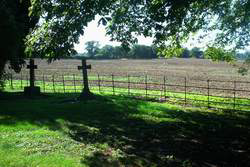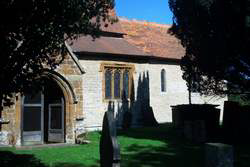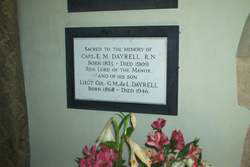Abandoned Communities ..... Buckinghamshire
Back to Lillingstone Dayrell. Lillingstone Dayrell was visited by Maurice Beresford on 30 April 1955. He summarised his observations as “Isolated church, distant from both rectory and Hall. Bumps and hollow ways medium quality in grass field between church and main road. Impressive fishpond in field between road and rectory on opposite side from village.”
In recent years the field referred to by Beresford has been ploughed every two years. The bumps and hollow ways are now very hard to discern. Each ploughing, however, exposes huge quantities of stone fragments and sherds of pottery. Lillingstone Dayrell comes within the region covered by the Whittlewood Project that has been conducting research into the medieval landscape. The field in question was explored through systematic fieldwalking in the autumn of 2000. Analysis of the location of pottery revealed the way in which the community began to grow in the early medieval period, expanded after the Norman conquest and then contracted again in the late medieval period. When the village was at its height it appears there were parallel streets running west to east and also houses fronting on to the main road from Buckingham to Towcester, now the A413.
I would strongly recommend a visit to the website of the Whittlewood Project.
Go to this address for the Project’s homepage, or this address for the page on Lillingstone Dayrell.
Since the fieldwalking was carried out the field has continued to be a favourite spot for people with metal detection equipment.
The church in Lillingstone Dayrell is still in use. In common with Wharram Percy and many other deserted medieval villages an isolated church has survived the abandonment of the rest of the village. In some places the church continued to serve as a place of worship for people from neighbouring communities. Elsewhere it was kept for the use of the lord of the manor, his family, and his staff.
At Lillingstone Dayrell the church functions as a memorial to many generations of the Dayrell family. A fine brass monument can be seen on top of a rectangular tomb. It depicts Paul and Margaret Dayrell, and states that Paul died on 29 March 1491 (two years before the evacuation of the village by Thomas Dayrell). Paul is shown wearing armour, while Margaret has a splendid headdress. In the centre of the chancel is a more grandiose tomb bearing stone effigies of a later Paul Dayrell, who died in 1556, and his third wife Dorothy, who died in 1571. On one side of the tomb are the kneeling figures of their nine sons and six daughters.
A booklet available at the church gives more information about the church and its history. It is The Church in the Fields by F H Mountney.
The last member of the Dayrell family at Lillingstone Dayrell was Edmund Marmaduke Dayrell. Born in 1835 he served as a senior officer in the Royal Navy until retiring in 1880. Three years later he moved back into the Manor House. The Manor House had been built in 1792 near the west end of the church, replacing a previous manor house on the same site. Before moving in E M Dayrell had organised an extensive restoration, but just four years later he decided to sell the whole estate. The manor house was demolished by its new owner in 1891.
In recent years the field referred to by Beresford has been ploughed every two years. The bumps and hollow ways are now very hard to discern. Each ploughing, however, exposes huge quantities of stone fragments and sherds of pottery. Lillingstone Dayrell comes within the region covered by the Whittlewood Project that has been conducting research into the medieval landscape. The field in question was explored through systematic fieldwalking in the autumn of 2000. Analysis of the location of pottery revealed the way in which the community began to grow in the early medieval period, expanded after the Norman conquest and then contracted again in the late medieval period. When the village was at its height it appears there were parallel streets running west to east and also houses fronting on to the main road from Buckingham to Towcester, now the A413.
I would strongly recommend a visit to the website of the Whittlewood Project.
Go to this address for the Project’s homepage, or this address for the page on Lillingstone Dayrell.
Since the fieldwalking was carried out the field has continued to be a favourite spot for people with metal detection equipment.
The church in Lillingstone Dayrell is still in use. In common with Wharram Percy and many other deserted medieval villages an isolated church has survived the abandonment of the rest of the village. In some places the church continued to serve as a place of worship for people from neighbouring communities. Elsewhere it was kept for the use of the lord of the manor, his family, and his staff.
At Lillingstone Dayrell the church functions as a memorial to many generations of the Dayrell family. A fine brass monument can be seen on top of a rectangular tomb. It depicts Paul and Margaret Dayrell, and states that Paul died on 29 March 1491 (two years before the evacuation of the village by Thomas Dayrell). Paul is shown wearing armour, while Margaret has a splendid headdress. In the centre of the chancel is a more grandiose tomb bearing stone effigies of a later Paul Dayrell, who died in 1556, and his third wife Dorothy, who died in 1571. On one side of the tomb are the kneeling figures of their nine sons and six daughters.
A booklet available at the church gives more information about the church and its history. It is The Church in the Fields by F H Mountney.
The last member of the Dayrell family at Lillingstone Dayrell was Edmund Marmaduke Dayrell. Born in 1835 he served as a senior officer in the Royal Navy until retiring in 1880. Three years later he moved back into the Manor House. The Manor House had been built in 1792 near the west end of the church, replacing a previous manor house on the same site. Before moving in E M Dayrell had organised an extensive restoration, but just four years later he decided to sell the whole estate. The manor house was demolished by its new owner in 1891.
Four
The ploughed field where pieces of stone and pottery, and small metal objects can be found
The church, including the porch added early in the fifteenth century
Paul and Margaret Dayrell
(with apologies for the foreshortening)
(with apologies for the foreshortening)
Some of the children of Paul and Dorothy Dayrell
Memorial to Edmund Marmaduke Dayrell




